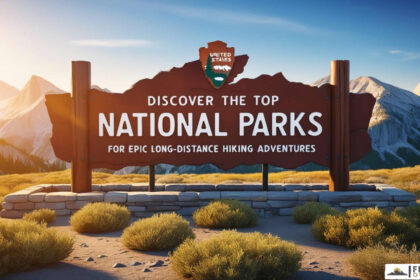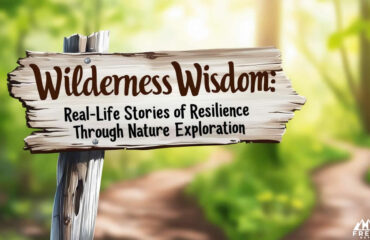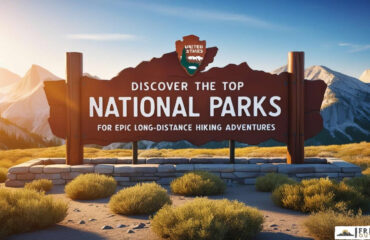
Discover the best national parks for long-distance hiking, featuring diverse trails, breathtaking scenery, and unique outdoor experiences.
The Appeal of Long-Distance Hiking in National Parks
Long-distance hiking in national parks has captivated outdoor enthusiasts for decades, offering breathtaking natural landscapes and the chance to immerse oneself in nature over extended periods. Many hikers are drawn to the serenity and isolation that these trails provide, allowing them to disconnect from the fast-paced world and reconnect with themselves. The appeal lies not only in the stunning scenery but also in the physical and mental benefits that come from such activities. Engaging in long-distance hiking promotes cardiovascular health, builds muscle endurance, and enhances mental well-being, allowing hikers to experience a profound sense of accomplishment and clarity during their journeys.
Choosing the right national park can significantly enhance the hiking experience. Each park boasts unique ecosystems, terrains, and climates, making it essential for hikers to consider which environment aligns with their interests and abilities. For example, the lush forests of Olympic National Park provide a stark contrast to the arid desert landscapes found in Joshua Tree National Park, catering to different preferences and skill levels. Parks like Yosemite offer iconic landmarks such as Half Dome, while others like the Grand Canyon present geological formations that tell the story of millennia. This diversity in national parks ensures that every hiker can find a trail that resonates with their personal adventure goals.
Moreover, long-distance hiking fosters community among those who share this passion. Hikers often form connections along the trail, sharing their experiences, challenges, and triumphs. This sense of camaraderie can be particularly rewarding, as it enhances the overall experience of long-distance hiking and provides support during challenging segments of the journey. Whether it’s a casual chat at a campsite or an organized hiking group, the relationships formed on these trails can last a lifetime.
The Pacific Crest Trail
The Pacific Crest Trail (PCT) is one of the crown jewels of long-distance hiking in the United States, stretching a remarkable 2,650 miles from Mexico to Canada. This trail features a diverse array of terrains, including deserts, pristine alpine meadows, and lush forests, with iconic national parks such as Yosemite and Lassen Volcanic National Park along its route. Hikers are drawn to the PCT for its varied ecosystems and iconic vistas, making it a premier choice for those seeking a rich hiking experience. The trail passes through several climate zones, enabling hikers to witness dramatic changes in flora and fauna as they traverse its length.
However, the PCT also presents challenges, notably long stretches without water, which require hikers to plan carefully and manage their water supply effectively. For instance, sections of the trail in the Southern California desert can stretch over 20 miles without a reliable water source, necessitating meticulous planning and heavy packs. Fortunately, the trail is divided into manageable sections, allowing hikers to customize their journey and opt for shorter hikes that still offer the thrill of long-distance trekking. Many hikers tackle the PCT in sections over several years, allowing them to savor the experience without the pressure of completing it all at once.
The PCT is not only about the physical challenge; it also fosters a deep connection with nature. Hikers often report life-changing experiences as they immerse themselves in the wilderness, providing opportunities for personal growth and reflection. The variety of landscapes—from the arid deserts of Southern California to the lush, green forests of the Pacific Northwest—creates a dynamic environment that enriches the hiking experience. This diversity, along with the chance to encounter wildlife such as bears, deer, and various bird species, makes the PCT a memorable journey for those who venture along its path.
The Appalachian Trail
Spanning 2,198 miles, the Appalachian Trail (AT) is recognized as the longest hiking-only trail globally and traverses 14 states from Georgia to Maine. Renowned for its “green tunnel” experience, the trail is enveloped in lush vegetation that provides stunning views and a sense of seclusion. The AT is particularly famous for its challenging elevation changes, especially in areas like the White Mountains, which reward hikers with breathtaking panoramas. Hikers often experience the full spectrum of the seasons, from colorful autumn foliage to winter’s serene snow-covered landscapes, making each hike unique.
Hikers on the AT benefit from over 250 shelters and campsites, strategically placed to offer crucial resting spots during their journey. This network of shelters allows for easy planning, making the trail accessible to both novice and seasoned hikers. The Appalachian Trail Conservancy provides invaluable resources for planning and navigating this extensive route, ensuring that both novice and experienced hikers can enjoy their adventure safely and efficiently. The trail is well-marked, and the community of hikers often shares tips and advice, contributing to a supportive network that enhances the hiking experience.
One of the most significant appeals of the AT is the sense of community it fosters among hikers. The trail sees thousands of through-hikers each year, many of whom participate in the annual “Thru-Hike” culture that celebrates completing the entire trail in a single season. This camaraderie is often felt at various trail towns where hikers gather to share stories, restock supplies, and enjoy local hospitality. Such interactions create lasting friendships, as many hikers find themselves bonded by the shared experience of tackling this challenging and rewarding trail.
The Continental Divide Trail
The Continental Divide Trail (CDT) is approximately 3,100 miles long and is famed for its rugged terrain and significant elevation changes. This trail provides a truly unique experience, allowing hikers to customize their adventure with alternate routes through the majestic Rocky Mountains. The CDT is less crowded than other major trails, providing a sense of solitude that appeals to many long-distance hikers. This solitude allows hikers to connect deeply with the wilderness, often leading to moments of introspection and a greater appreciation for nature.
However, the CDT is not without its challenges; climate change has increasingly affected trail conditions, posing safety risks for hikers. Reports of wildfires, heat waves, and unpredictable weather patterns have become more common, urging hikers to stay informed and prepared. For example, sections of the trail in Colorado can become dangerous due to rapid weather changes, making it essential for hikers to carry gear that can accommodate a range of conditions. Proper planning and understanding the trail’s specific challenges are vital for a safe and enjoyable hiking experience.
Wildlife encounters are common along the CDT, with hikers often spotting bears, moose, and other wildlife, which necessitates knowledge of safety precautions in bear country. The trail provides opportunities to observe these majestic animals in their natural habitats, adding to the adventure. Hikers should be aware of how to store food safely and respond to wildlife encounters to ensure both their safety and the well-being of the animals. The combination of rugged terrain, stunning landscapes, and the thrill of possible wildlife sightings makes the CDT a compelling option for long-distance hikers seeking an immersive outdoor experience.
The John Muir Trail
The John Muir Trail (JMT) runs for 211 miles through some of California’s most iconic national parks, including Yosemite, Sequoia, and Kings Canyon. Best hiked between July and September, the trail showcases breathtaking mountain scenery and features significant landmarks such as Half Dome and Mount Whitney, making it a bucket-list item for many hikers. The JMT overlaps with the Pacific Crest Trail for a portion, allowing hikers to experience the best of both trails. Its challenging altitude and elevation profile provide an exhilarating experience for those willing to test their limits.
Due to its popularity, the JMT requires a permit for access, which emphasizes the importance of planning ahead. Hikers must secure their permits well in advance, particularly for the peak summer months when demand is highest. The necessity of the permit system helps to manage trail traffic and preserve the natural environment, ensuring that the beauty of the trail can be enjoyed by future generations. This additional layer of planning encourages hikers to be proactive in their preparation for the journey ahead.
Hikers should also prepare for altitude challenges, as the trail reaches elevations exceeding 13,000 feet, which can be demanding even for experienced trekkers. Acclimatization is crucial; many hikers choose to arrive a few days early to adapt to the altitude before embarking on the trail. Along the way, hikers are rewarded with stunning vistas of granite peaks, alpine lakes, and wildflower-filled meadows, creating a visual feast that highlights the beauty of the Sierra Nevada. The combination of breathtaking scenery and the physical challenge of high-altitude hiking makes the JMT a remarkable experience for anyone passionate about long-distance trekking.
Olympic National Park
Olympic National Park offers a unique hiking experience, highlighted by the 17.5-mile Wild Olympic Coast hike, which features stunning sea stacks and tide pools. The park is particularly appealing for beginner hikers, as it provides less crowded trails that allow for a more relaxed outdoor experience. With diverse ecosystems ranging from rainforests to rugged coastlines, Olympic National Park enhances the hiking journey with spectacular landscapes and abundant wildlife, including elk and sea otters. This variety allows hikers to experience multiple environments within a single park, enriching their adventure.
Despite its appeal, hikers should be aware of the significant rainfall in the region, as it can occur year-round. Proper preparation for wet conditions is essential to ensure a safe and enjoyable hike. Waterproof gear, quick-drying clothing, and appropriate footwear are vital for tackling the often muddy and slippery trails. Additionally, understanding tide schedules is crucial for those hiking along the coast to avoid being caught in high water during rising tides. This careful planning allows hikers to fully enjoy the park’s natural beauty without undue stress.
The park’s extensive trail network provides opportunities for both short and long hikes, catering to different skill levels and time constraints. Well-maintained trails lead to stunning destinations such as Hurricane Ridge and Hoh Rain Forest, offering options for both day hikes and extended backpacking trips. The diversity of trails allows visitors to tailor their experience based on their interests, whether it’s a leisurely stroll through ancient forests or a more strenuous trek to coastal overlooks. Each hike in Olympic National Park is an opportunity to connect with nature and witness the park’s remarkable biodiversity.
Grand Canyon National Park
Grand Canyon National Park is renowned for its stunning geological formations and breathtaking vistas. The Rim-to-Rim hike spans 24 miles and is tailored for experienced hikers due to its extreme elevation changes. Along the trail, several campgrounds provide essential resting spots, but careful planning for water and supplies is crucial to navigate the canyon’s challenges successfully. One of the most popular routes, the Bright Angel Trail, offers a well-marked path with rest houses and water stations, making it accessible for those attempting the rim-to-rim hike.
The Grand Canyon provides a unique opportunity to witness the geological history of the Earth, exposing layers of rock that tell a story over billions of years. The vibrant colors of the canyon walls, especially at sunrise and sunset, create a remarkable visual experience that hikers will remember long after their journey. The steep descent into the canyon rewards hikers with spectacular views of the Colorado River and the complex canyon ecosystem, showcasing the park’s natural beauty in a way that day hikes cannot replicate.
Hikers should be mindful of the drastic temperature variations between the canyon rim and the floor, which can pose additional challenges during the hike. The temperature at the rim can be significantly cooler than at the canyon floor, sometimes resulting in hikers underestimating the heat they may face. Proper hydration and sunscreen are essential to ensure safety during the descent and ascent. The physical demands of the hike, combined with the stunning scenery and geological significance, make the Grand Canyon an unforgettable destination for long-distance hikers.
Glacier National Park
Glacier National Park features a 65-mile Northern Loop hike that showcases diverse wildlife and stunning mountain views. With climate change threatening the park’s glaciers, there is a sense of urgency to experience this natural wonder before it disappears. The park offers over 700 miles of trails, catering to hikers of all levels and providing numerous options for long-distance trekking. The combination of rugged terrain and picturesque landscapes makes Glacier a top choice for those seeking adventure in the great outdoors.
As wildlife encounters, including grizzly bears, are common, practicing bear safety is essential for all hikers. Understanding how to store food properly and carry bear spray can significantly enhance hiker safety. Glacier National Park is home to a variety of ecosystems, from lush valleys to high alpine environments, which provide opportunities to observe diverse wildlife in their natural habitats. Hikers may encounter not only bears but also mountain goats, deer, and a plethora of bird species, enriching the hiking experience.
The urgency to experience the park’s glaciers adds to the motivation for many hikers. As glaciers retreat due to climate change, witnessing these natural formations becomes increasingly important. The park’s stunning vistas offer not only physical challenges but also opportunities for hikers to reflect on the environment and the impact of climate change on these beautiful landscapes. Each hike in Glacier National Park is not just a journey through nature, but an invitation to engage with pressing environmental issues that affect the region and the planet.
Zion National Park
Zion National Park is famous for its breathtaking landscapes, with the 16-mile Narrows hike providing a unique backcountry camping experience. The park is characterized by its towering canyon walls and stunning vistas, making it ideal for multi-day hikes that allow hikers to fully appreciate the natural beauty. The Narrows, in particular, offers a combination of hiking and wading through the Virgin River, creating an immersive experience that few other trails can match.
Access to popular trailheads during peak seasons is facilitated by shuttle services, which helps manage visitor traffic. This service is crucial for maintaining the park’s delicate ecosystems while allowing hikers to explore its wonders efficiently. However, hikers should be aware of the risks of flash floods in narrow canyons, particularly during the summer months, and should plan their hikes accordingly. Understanding the weather patterns and river conditions is vital for safety, as sudden storms can lead to dangerous conditions in the canyons.
Zion also offers a variety of other trails that cater to different skill levels, providing options for both beginners and experienced hikers. Trails such as Angels Landing and Observation Point offer stunning views of the canyon below, rewarding hikers with panoramic vistas that are well worth the effort. The park’s topography allows for diverse hiking experiences, from easy walks to challenging scrambles. Each hike provides a unique opportunity to connect with the park’s dramatic geological features and rich history, making Zion National Park a must-visit destination for long-distance hikers.
Sequoia National Park
Sequoia National Park offers a remarkable 40-mile loop in the Mineral King area, showcasing the majestic giant sequoias and high mountain passes. The park is ideal for long-distance hiking, providing solitude and breathtaking views of the High Sierra. Hiking among the giant sequoias, some of the largest trees on earth, offers a truly unique experience that few other parks can replicate. The towering trees create a sense of wonder and inspire awe, reminding hikers of the natural beauty and history of these ancient giants.
However, hikers must be prepared for the challenges posed by elevation changes and potential weather conditions. The park’s high-altitude trails can lead to rapid weather shifts, making it essential for hikers to bring appropriate gear and clothing. Planning for various conditions is vital; temperatures can fluctuate dramatically, especially at higher elevations. Additionally, hikers should be aware of the limited cell service in the area, which necessitates good navigation skills and a reliable map.
The park’s diverse trail system allows hikers to explore various ecosystems and terrains, from alpine lakes to dense forests. Each hike presents an opportunity to witness the unique flora and fauna that thrive in this environment. The combination of stunning views, ancient trees, and the physical challenges of high-altitude hiking makes Sequoia National Park a captivating destination for long-distance hikers seeking adventure and connection with nature.
The North Country National Scenic Trail
The North Country National Scenic Trail is the longest trail in the National Park System, stretching an impressive 4,600 miles across eight states. This trail features diverse landscapes, including Great Lakes shorelines and glacial valleys, providing a variety of ecosystems for hikers to explore. The North Country Trail is primarily maintained by volunteers, fostering community engagement in trail conservation and enhancing the hiking experience for all who venture along its path. These volunteers play a crucial role in maintaining the trail, ensuring it remains accessible and well-marked for hikers.
Hikers can connect with several state parks and local trails along the route, enhancing accessibility and offering a variety of experiences throughout their journey. This interconnected network allows hikers to customize their adventures based on their interests and time constraints, making the trail adaptable for both day trips and longer excursions. The trail also showcases the beauty of the Midwest and Northeast, with opportunities to experience forests, wetlands, and prairies, making it a diverse hiking destination.
The North Country Trail encourages a deep appreciation for the environments it traverses. Hikers often encounter unique wildlife and plant species native to each region, enriching their outdoor experiences. The trail represents not just a physical journey but also a journey through diverse ecosystems, highlighting the importance of conservation and environmental stewardship. As hikers traverse this extensive trail, they engage with nature and develop a deeper understanding of the landscapes they explore, fostering a sense of responsibility to protect these natural treasures for future generations.
Summary of Hiking Opportunities in National Parks
The diverse hiking opportunities across various national parks present a wealth of options for outdoor enthusiasts. From the iconic trails like the Pacific Crest Trail and Appalachian Trail to the less-traveled paths of the North Country Trail, each hike provides a unique experience and connection to the natural world. However, it is vital for hikers to consider the environmental impacts of climate change and prepare adequately.
Preparation includes physical fitness, selecting appropriate gear, and understanding safety measures for long-distance hiking. By planning carefully and respecting the environment, hikers can fully enjoy the incredible beauty and opportunities offered by these national treasures. Engaging with the trails not only enhances personal well-being but also fosters a greater appreciation for the importance of preserving these natural landscapes for future generations.




